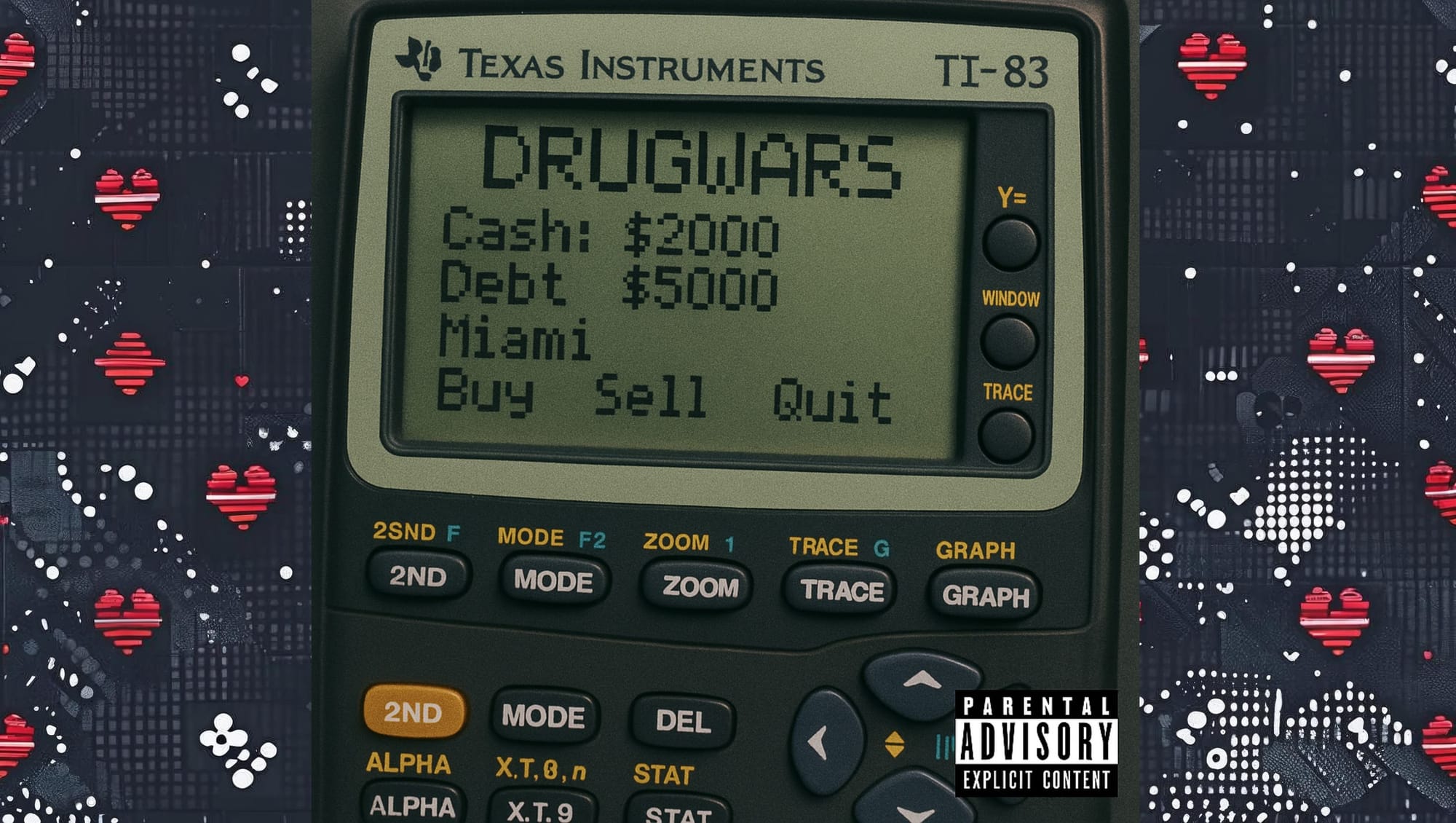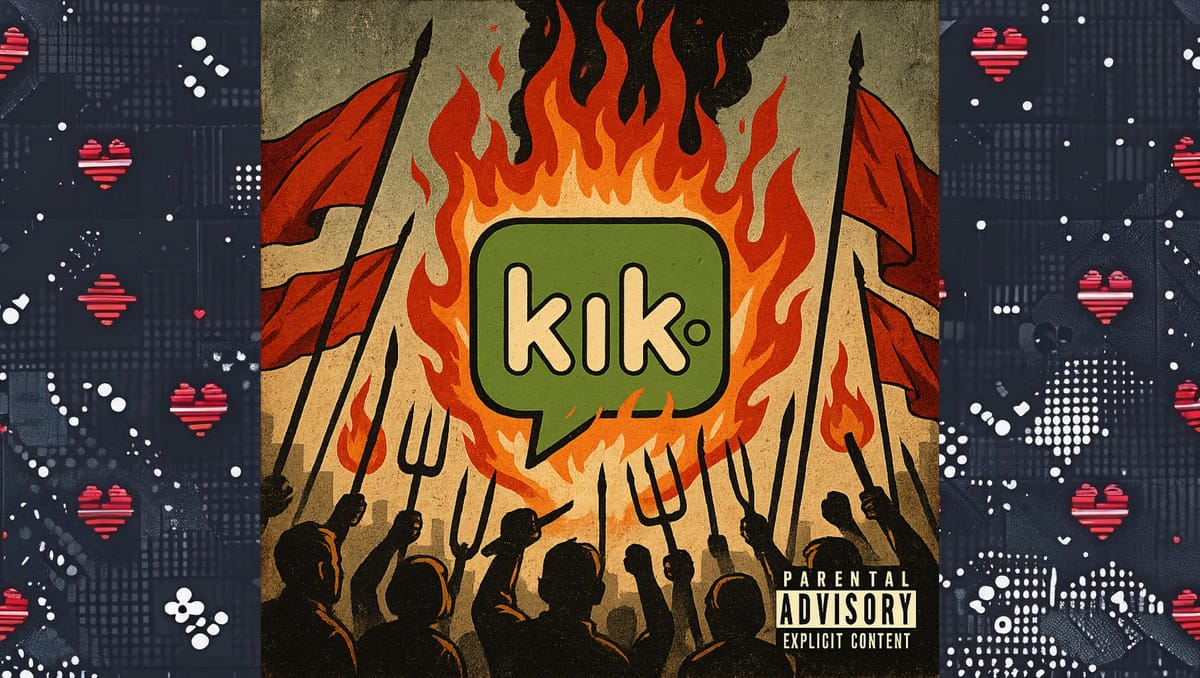TI-83 DrugWars

Algebra II, 1998. The rows of plastic calculators on every desk looked like prison-issue gear for math class. The TI-83 was supposed to teach us to graph parabolas and grind toward the SAT, but what it really taught a generation of nerds was how to hustle. Inside that little green-and-black screen lived a contraband text sim called Drug Wars, and once it spread, the classroom was never the same.123
The story starts earlier, in 1984, on MS-DOS. John E. Dell wrote a bare-bones economic game: borrow from a loan shark, buy drugs low in one borough, sell high in another, survive the interest, dodge the cops. No sprites, no soundtrack — just ASCII, numbers, and pain. Thirty in-game days. Prices spiking and crashing. Random events that could erase your bankroll in a heartbeat. Capitalism in a trench coat, rendered in text.4567
Almost a decade later, a high-schooler named Jonathan Maier ported it to the TI-82 in TI-BASIC. Suddenly the hustle fit in your pocket. Distribution didn’t happen through stores or websites; it moved across those gray link cables kids used to beam programs from calc to calc — sneaker-net before broadband, hallway P2P before Napster. One friend loaded it, two friends copied it, by lunch the whole building was running digital cartels. Teachers could confiscate a calculator, but they couldn’t outlaw the hardware the class required. The device was mandatory. The game was forbidden. That tension is exactly why it went viral.89101112
The loop was simple and brutal. Your trench coat could only hold so much — inventory cap as game design. Each “day” you chose where to travel, gambling on whether coke would crash in the Bronx or pop in Manhattan. Sometimes you got mugged. Sometimes the cops bled you with “fees.” And over all of it loomed compounding interest — the nastiest math problem in the building, and the one your textbook didn’t dramatize. Everyone remembers ending a run broke, in debt, with days still left on the clock. It felt real because the mechanics were real.131415
Schools tried to fight back. Admins banned the program, confiscated units, called parents. That only gave it more mystique. Students responded by reskinning the code — Coffee Wars, Donut Wars — same volatility, safer optics. It looked like a joke, but it was our first lesson in how software mutates to survive. Long before “meme culture,” calculator kids were patching contraband games to keep the economy online.1617
For the kids who played, the education ran deeper than algebra. Drug Wars was a crash course in markets: arbitrage, inventory constraints, liquidity, risk management, and the tyranny of compounding debt. You learned that sometimes the right move is to hold. You learned that carrying capacity matters more than bravado. You learned that variance can nuke a perfect plan. It was half contraband, half MBA, taught on a graphing calculator that every guidance counselor swore you needed for trig.18191
In hindsight, the phenomenon reads like a clean business case. The product itself was comically simple — text prompts and a few variables — but the distribution was bulletproof. Link cables created a peer-to-peer network in the one environment where the “platform” could not be banned: the classroom. The moat wasn’t code; it was institutional lock-in around the TI-83 and its Z80-based lineage. And the legacy is easy to trace: sideload culture flowing into jailbroken iPhones, modded Minecraft servers, and a thousand underground app economies that thrive wherever official channels get precious.9202122
That’s why Drug Wars deserves more than a nostalgic nod. It wasn’t just the game that made math class tolerable. It was proof that distribution beats product, that forbidden code outruns sanctioned content, and that sometimes the most important education happens in the margins of what the system says it’s teaching you.
References & Notes
| # | Term / Figure | Definition | Source |
|---|---|---|---|
| 1 | TI-83 (Graphing Calculator) | Ubiquitous 1990s classroom graphing calculator; programmable; effectively required for Algebra/Trig curricula. | Wikipedia: TI-83 series |
| 2 | Parabolas / SAT | Graphing quadratic functions was a core TI-83 use case; the SAT was the dominant U.S. college-entrance exam. | Wikipedia: Quadratic function · Wikipedia: SAT |
| 3 | Graphing Calculator (category) | Handheld calculators capable of plotting graphs and running programs; expanded K-12 computing before smartphones. | Wikipedia: Graphing calculator |
| 4 | Drug Wars (1984) | Turn-based trading sim by John E. Dell for MS-DOS; ancestor to later Dope Wars and calculator ports. | Wikipedia: Drug Wars |
| 5 | MS-DOS | Dominant 1980s IBM-PC operating system that ran early text-based games like Drug Wars. | Wikipedia: MS-DOS |
| 6 | ASCII | Character encoding for text; many early DOS games were “ASCII art” with zero graphics beyond characters. | Wikipedia: ASCII |
| 7 | Loan shark | High-interest, often illegal lending; the compounding interest risk is central to Drug Wars gameplay. | Wikipedia: Loan shark |
| 8 | Jonathan Maier (TI port) | High-school student credited with an early TI-82 port of Drug Wars in TI-BASIC, spreading via schools. | WIRED: The Calculator Game That Went Viral |
| 9 | TI-BASIC | Built-in programming language for TI calculators, enabling student-written apps and games. | Wikipedia: TI-BASIC |
| 10 | TI Link Cable | Physical cable connecting calculators (or calc↔PC) to transfer programs; the viral distribution channel. | Wikipedia: TI Link Cable |
| 11 | Sneakernet | Physical transfer of files via removable media/cables — “walking” data between devices. | Wikipedia: Sneakernet |
| 12 | Napster / Peer-to-Peer | Late-1990s P2P music-sharing network; shorthand for viral, user-driven distribution. | Wikipedia: Napster · Wikipedia: Peer-to-peer |
| 13 | Inventory capacity (“trench coat”) | A core constraint in most ports — limited carry slots that force tradeoffs and risk management. | Game design: mechanics |
| 14 | Compounding interest | Interest added to principal so that interest also earns interest; punishing in short-horizon sims. | Investopedia: Compound Interest |
| 15 | Random events (muggings, cops) | Stochastic shocks in Drug Wars/Dope Wars variants that swing outcomes regardless of plan. | Wikipedia: Drug Wars – Gameplay |
| 16 | ticalc.org | Long-running community archive for TI programs (BASIC/ASM), including trading-game reskins. | ticalc.org |
| 17 | “Candy/Coffee/Donut Wars” | Classroom-safe reskins of Drug Wars to evade confiscation while keeping price-swing mechanics. | ticalc.org: Candy Wars (TI-83/84) |
| 18 | Arbitrage & liquidity | Buying low/selling high across fragmented markets; liquidity limits how fast you can pivot out of risk. | Investopedia: Arbitrage · Wikipedia: Liquidity |
| 19 | TI-83 hardware (Z80) | The TI-83 line used a Zilog Z80-compatible CPU, enabling simple assembly and BASIC programs. | Wikipedia: Zilog Z80 |
| 20 | iOS jailbreaking / sideloading | Installing unofficial apps by removing Apple’s restrictions or loading apps outside the App Store. | Wikipedia: iOS jailbreaking · Wikipedia: Sideloading |
| 21 | Minecraft mods / servers | Community-built code that changes gameplay; often run on independent servers outside official rails. | Wikipedia: Minecraft mods |
| 22 | Grand Theft Auto (analogy) | Iconic open-world crime series; used here as a cultural analogy for taboo, system-driven play. | Wikipedia: Grand Theft Auto |



